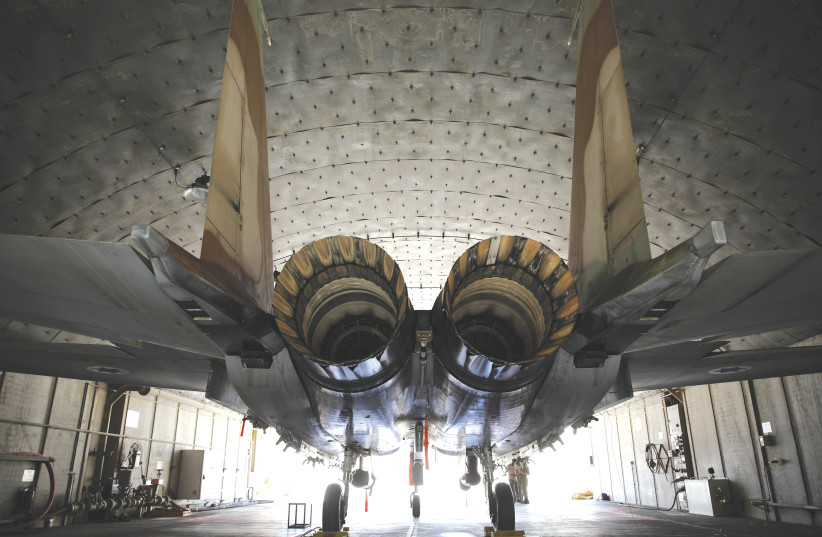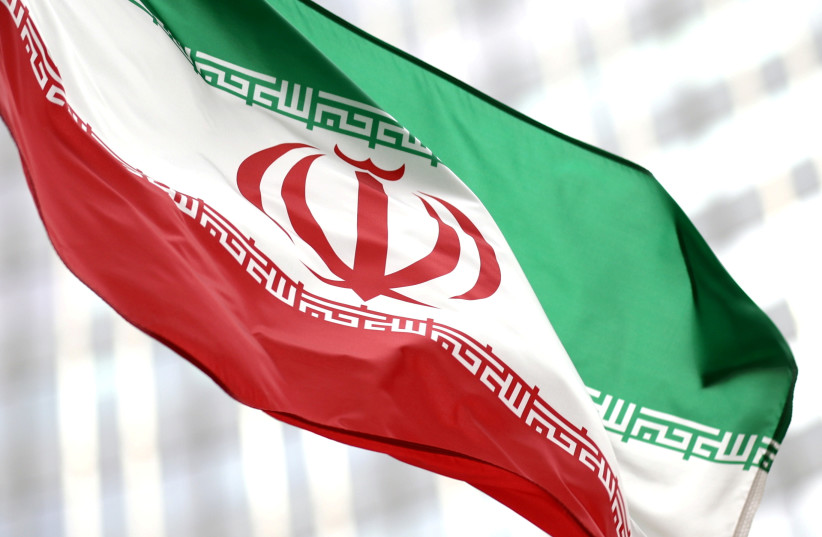by Yaakov Katz
Will an overt airstrike on Iran really achieve so much more for Israel in terms of a delay than continued covert operations?
 |
An Israeli F-15 fighter jet is seen from behind at Uvda Airbase in southern Israel.
(photo credit: AMIR COHEN/REUTERS)
|
The targets in Iran would vary.
The first would be Natanz,
Iran’s main uranium enrichment facility. The complex consists of two
large halls, roughly 300,000 square feet each dug somewhere between
eight and 23 feet below ground and covered by several layers of concrete
and metal. The walls of each hall are estimated to be approximately two
feet thick. The facility is also surrounded by surface-to-air missiles.
The
next facility would be the heavy-water plant under construction near
the town of Arak, which could be used one day to produce plutonium.
Iranians say the material will be used for medical and research isotope
production, but in reality could have the ability to produce plutonium
for nuclear weapons.
Next
is Iran’s Uranium Conversion Facility (UCF), located at the Isfahan
Nuclear Technology Center. Based on satellite imagery, the facility is
above ground, although some reports have suggested tunneling near the
complex.
And then there is Fordow,
the uranium enrichment facility near the city of Qom, not far from the
Caspian Sea. Officially revealed to the IAEA in 2009, the facility can
hold thousands of centrifuges. Built into a mountain, it would be
difficult to penetrate the hardened facility. Former defense minister
Ehud Barak has noted more than once that the facility is “immune to
standard bombs.”

Military
planners would also likely feel compelled to attack Iran’s centrifuge
fabrication sites, since their destruction would make it extremely
difficult for Iran to reestablish its program – although the destruction
of Natanz, Arak and Isfahan on their own would be enough to set back
the ayatollah’s dream of obtaining the bomb.
In
addition to these key targets, the attacker would also want to bomb
Iranian radar stations, missile bases, silos and launchers as well as
air bases, with the aim of knocking out Iran’s ability to strike back
with its long-range missiles or combat aircraft.
This plan on how Israel might attack Iran was published in 2012, in a book entitled Israel vs. Iran – The Shadow War, authored by Yoaz Hendel, at the time a columnist with Yediot Aharonot, and me, at the time this paper’s defense analyst.
Back
then, some Israeli officials also called for bombing Iran’s oil fields
and energy infrastructure. Such strikes, they believed, could have a
demoralizing effect on Iran and influence the regime’s decision-making
process. Oil revenues provide a significant portion of Tehran’s
government income. The oil facilities are also vulnerable and lack
surface-to-air missile protection.
One
former IDF general claimed at the time that in total, Israel would have
to strike close to 100 primary targets, possibly in sorties lasting two
days.
But, we asked then, can Israel do it?
The
main problem Israel would encounter in attacking Iran’s nuclear
facilities, we pointed out, is the physical distance that is over 700
miles from Israel, with the main targets even further at distances
ranging between 1,000 and 1,500 miles from Israel.
According
to most estimates, Israel is capable of unilaterally attacking Iran’s
nuclear facilities with its F-16 and F-15 aircraft. Israel’s vaunted 25
F-15Is – Ra’am (Thunder) in Hebrew – that are based in the Negev are
believed to be capable of striking Iran in a non-stop operation like
Operation Opera against Iraq in 1981, with a combat range of over 2,000
miles. Israel in 2010 also finished receiving 102 F-16Is – Sufa (Storm)
in Hebrew – that it procured in the late 1990s. These too are capable of
long-range missions, with a combat radius of over 1,000 miles.
There
were three possible routes that we outlined in 2012 for Israel to fly
to Iran. The northern route, which skirts along the Turkish-Syrian
border into Iran; the central route, which is the most direct but
entails serious diplomatic obstacles; and the southern route, which
would take Israeli planes over Saudi Arabia and into Iran.
Back then, the IAF had some of the munitions needed to destroy the
Iranian facilities and penetrate the fortified bunker in Natanz, either
developed domestically or purchased over the years from the United
States, such as the GBU-27 and GBU-28 that can carry anywhere from 1,000
to 3,000 pounds of explosives. While Natanz is one of the most
difficult targets, even if the missiles on their own will not succeed in
penetrating, Israeli pilots could glide them in.
Former
Israeli Air Force commander Maj.-Gen. Eitan Ben-Eliyahu, who
participated in the strike on Osirak in 1981, explained how this would
happen. Even if one bomb would not suffice to penetrate a target, he
explained in 2005, Israel could guide other bombs into the area of where
it has attacked to eventually destroy the target.
Israel,
according to foreign reports, could also – we noted at the time –
potentially utilize its Jericho road-mobile, two-stage solid-propellant
missile, which has a range varying from 1,200 to over 3,000 miles, and
is capable of carrying a one-ton conventional or non-conventional
warhead. The latest version of the missile called Jericho III and tested
in early 2008 has enhanced accuracy, and puts every Arab capital,
including Tehran, within striking distance of Israel.
NEEDLESS TO say, a lot has changed since that was written 10 years ago.
- Israel has upgraded its weapons and platforms, like the F-35 that is capable of covertly flying into Iranian airspace and taking out radar stations, which would then enable non-stealth aircraft to enter with a fuselage loaded with bombs without risk.
- There are new munitions the IAF has acquired, and as illustrated by recent covert operations, the country’s intelligence on Iran is deep and extensive.
- The route possibilities themselves have completely changed. Flying over Syria today is not like it was in 2012, when Bashar Assad still had an advanced military, and Israel rarely entered his airspace; America is no longer deployed in Iraq the way it was then; and the Abraham Accords have changed the dynamic between Israel and Saudi Arabia. El Al planes today openly fly over Saudi Arabia. Does that mean Riyadh would let IAF fighter jets do the same? Maybe.
- But what has also changed is Iran, and the progress it has made in its nuclear program. What people often overlook when considering whether Jerusalem can go it alone against Tehran is that the technical know-how is Iranian. It is not from a foreign source, like was the case of the Syrian reactor destroyed by Israel in 2007 (North Korea), or the Iraq reactor destroyed by Israel in 1981 (French).
- What this means is that even if Israel attacks and succeeds in causing extensive damage, Iran will not need help to rebuild it – Tehran will be able to do it all over again on its own. Now one could argue that due to domestic and international pressure, Iran might be slow to rebuild its nuclear infrastructure after a strike, but there is another case to make as well: that the ayatollahs will be emboldened by the Israeli strike as the world instead cracks down on Israel for acting unilaterally.
The
other main difference is that in 2012, Israel’s option was viable and
real. The Air Force was sharp, and the pilots were trained and knew
their targets. But they were never given the green light, and that
capability instead fell to the side; and Israel missed its window of
opportunity to act.
Is
it too late now? I don’t know. In the IDF, the generals are confident –
as illustrated by the arrogance the incoming commander of the IAF
exhibited in the media this week – that they can get the job done. And
they are, God willing, probably right.
Israel’s
military is powerful, and could definitely deal Iran a blow that would
set back and delay its nuclear progress. But there are questions that
need to be asked: will an overt airstrike really achieve so much more in
terms of a delay than continued covert operations? Is the war that will
ensue worth just a few years delay? And is the diplomatic fallout
something Israel can sustain for an undefined achievement?
Ten
years have passed since Hendel and I wrote that plan. Parts of it are
still relevant. Others are not. What is for certain is that in the time
that has passed since then, Iran has not been stopped. It has grown
stronger, more audacious, more advanced – and Israel failed to prevent
that from happening.
How much longer?
Yaakov Katz
Source: https://www.jpost.com/opinion/article-689634
No comments:
Post a Comment